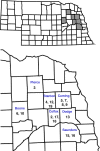Resistance management and integrated pest management insights from deployment of a Cry3Bb1+ Gpp34Ab1/Tpp35Ab1 pyramid in a resistant western corn rootworm landscape
- PMID: 38457466
- PMCID: PMC10923451
- DOI: 10.1371/journal.pone.0299483
Resistance management and integrated pest management insights from deployment of a Cry3Bb1+ Gpp34Ab1/Tpp35Ab1 pyramid in a resistant western corn rootworm landscape
Abstract
In Nebraska USA, many populations of western corn rootworm (WCR), Diabrotica virgifera virgifera LeConte, now exhibit some level of resistance to all corn rootworm-active Bacillus thuringiensis Berliner (Bt) proteins expressed in commercial hybrids. Therefore, a study was conducted in northeast Nebraska from 2020-2022 to reevaluate current corn rootworm management options in continuous maize (consecutive planting for ≥2 years). Results from on-farm experiments to evaluate a standard soil-applied insecticide (Aztec® 4.67G) in combination with non-rootworm Bt or rootworm-active Bt pyramided maize (Cry3Bb1 + Gpp34Ab1/Tpp35Ab1) are reported within the context of WCR Bt resistance levels present. Corrected survival from Bt pyramid single-plant bioassays (<0.3, 0.3-0.49, >0.5) was used to place populations into 3 resistance categories. Variables evaluated included root injury, adult emergence, proportion lodged maize, and grain yield. Key results: A composite analysis of all populations across resistance levels indicated that addition of soil insecticide to Bt pyramid significantly reduced adult emergence and lodging but did not significantly increase root protection or yield. Within and among resistance category analyses of root injury revealed that the Bt pyramid remained highly efficacious at any non-rootworm Bt root injury level when resistance was absent or low. When corrected survival was >0.3, mean Bt pyramid root injury tracked more closely in a positive linear fashion with mean non-rootworm Bt root injury (rootworm density x level of resistance interaction). Similar trends were obtained for adult emergence but not yield. Mean Bt pyramid root injury rating was <0.75 in most populations with Bt resistance, which contributed to no significant yield differences among categories. Results are discussed within the context of IPM:IRM tradeoffs and the need to reduce WCR densities in this system to decrease the impact of the density x resistance interaction to bridge use of current pyramids with new technologies introduced over the next decade.
Copyright: © 2024 Meinke et al. This is an open access article distributed under the terms of the Creative Commons Attribution License, which permits unrestricted use, distribution, and reproduction in any medium, provided the original author and source are credited.
Conflict of interest statement
The authors have declared that no competing interests exist. LJM developed the research concept/study design to improve western corn rootworm IRM and IPM when Bt pyramids are deployed in a corn rootworm resistant landscape. LJM wrote/submitted proposals to Bayer CropScience and Pioneer Hi-Bred International (Corteva). Industry authors provided materials, information integral to the project, and review of initial manuscript draft.
Figures



Similar articles
-
Evidence of western corn rootworm (Diabrotica virgifera virgifera LeConte) field-evolved resistance to Cry3Bb1 + Cry34/35Ab1 maize in Nebraska.Pest Manag Sci. 2022 Apr;78(4):1356-1366. doi: 10.1002/ps.6752. Epub 2021 Dec 19. Pest Manag Sci. 2022. PMID: 34873825
-
Characterizing the sublethal effects of SmartStax PRO dietary exposure on life history traits of the western corn rootworm, Diabrotica virgifera virgifera LeConte.PLoS One. 2022 May 25;17(5):e0268902. doi: 10.1371/journal.pone.0268902. eCollection 2022. PLoS One. 2022. PMID: 35613094 Free PMC article.
-
Effect of Bt maize and soil insecticides on yield, injury, and rootworm survival: implications for resistance management.J Econ Entomol. 2013 Oct;106(5):1941-51. doi: 10.1603/ec13216. J Econ Entomol. 2013. PMID: 24224233
-
Resistance to Bt maize by western corn rootworm: insights from the laboratory and the field.Curr Opin Insect Sci. 2016 Jun;15:111-5. doi: 10.1016/j.cois.2016.04.001. Epub 2016 Apr 13. Curr Opin Insect Sci. 2016. PMID: 27436740 Review.
-
Resistance to Bt Maize by Western Corn Rootworm: Effects of Pest Biology, the Pest-Crop Interaction and the Agricultural Landscape on Resistance.Insects. 2021 Feb 5;12(2):136. doi: 10.3390/insects12020136. Insects. 2021. PMID: 33562469 Free PMC article. Review.
Cited by
-
Western corn rootworm adult activity and immigrant resistance to Bt traits in first-year maize.PLoS One. 2025 Jun 13;20(6):e0325388. doi: 10.1371/journal.pone.0325388. eCollection 2025. PLoS One. 2025. PMID: 40512719 Free PMC article.
References
-
- Gillette CP. Diabrotica virgifera Lec. as a corn root-worm. J Econ Entomol. 1912; 5: 364–366. doi: 10.1093/jee/5.4.364a - DOI
-
- Bare OS. Corn rootworm does damage in southwestern Nebraska. Annual Report of Cooperative Extension Work in Agriculture and Home Economics, Entomology, State of Nebraska. The University of Nebraska-Lincoln: Lincoln, NE, USA. 1930; p. 21.
-
- Bare OS. Corn Rootworms. University Nebraska Cooperative Extension Circular 1506. The University of Nebraska-Lincoln: Lincoln, NE, USA, 1931.
-
- Branson TF, Ortman EE. Host range of larvae of the western corn rootworm. J Econ Entomol. 1967; 60: 201–203. doi: 10.1093/jee/60.1.201 - DOI
-
- Branson TF, Ortman EE. The host range of larvae of the western corn rootworm: Further studies. J Econ Entomol. 1970; 63: 800–803. doi: 10.1093/jee/63.3.800 - DOI
MeSH terms
Substances
LinkOut - more resources
Full Text Sources

